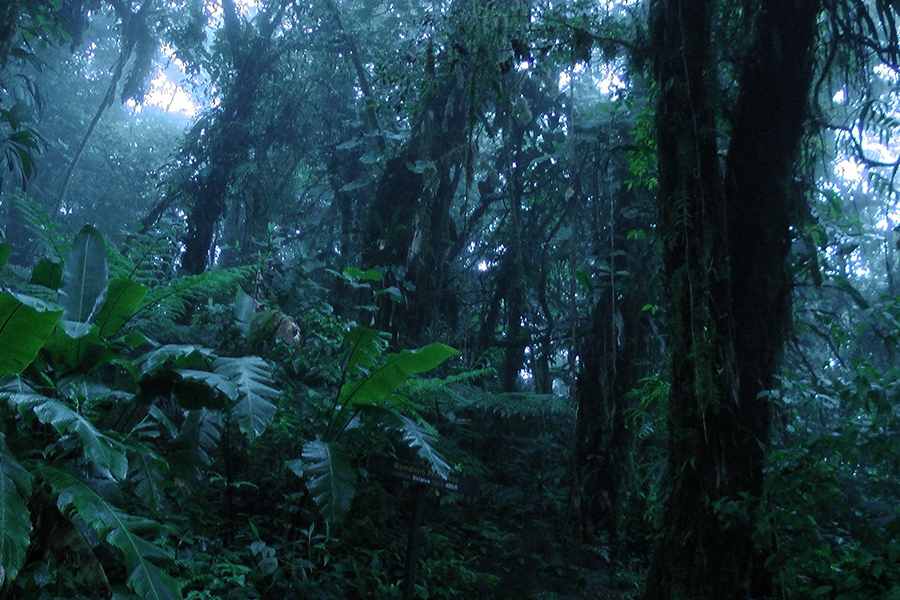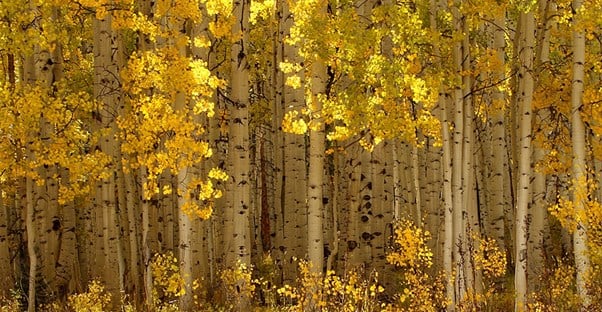14. Jiuzhaigou

Sichuan province, China
Jiuzhaigou, or "Nine Village Valley," is named for the nine Tibetan villages along its length. The lush forest is home to pandas and snub-nosed monkeys, and the area is dotted by dozens of clear lakes with unearthly blue, green, and turquoise hues. One word of advice—if you do come to Jiuzhaigou, come in the off-season, and be very mindful of the forest around you. The region sees over a million visitors each year, and the tourism is starting to threaten the ecology.
13. Kebler Pass

Colorado
This mountain pass is home to the largest Aspen grove in North America. Aspens are striking for two reasons. First, the vibrant gold color that they turn in the fall is blinding. The second is the sound they make when the wind runs through them. If you can look away from their gorgeous beauty for a moment, close your eyes and just listen to the sound. There's no music in the world like it.
12. Redwood National and State Parks

California
Redwoods are the tallest species of tree on earth. Most of them fell victim to logging, but here in California these breathtaking giants have a safe haven. Depending on how you define "big," some people hold that these trees are the biggest living organisms on the planet. When you're standing face to face with them, whether or not they earn the label doesn't seem to matter.
(image via erstwhilerags, CC | Visit Redwood National & State Parks)
11. Amazon Rainforest

Mainly Brazil, Peru, and Colombia
The Amazon is like no other place on earth. There are over 390 billion trees here, creating a canopy so rich and thick that light barely reaches the ground. This singular environment holds countless forms of animal life, as well. Two and a half million species of insects call this forest home, and one-fifth of every type of fish and bird on the planet lives here. There may not be a place richer in life anywhere else.
10. Hallerbos
9. Black Forest

Germany
Many people have only heard of the Black Forest because of the cake. They have no idea what they're missing out on seeing. The wooded mountain range is so dense with trees that the forest gets its name from the thick shadows which are cast. The old farming mills will only add to the feeling that you've fallen into a Brothers Grimm tale.
8. Aokigahara

Japan
The "Sea of Trees" is held by an unearthly quiet. The forest floor is made of volcanic rock and the trees are so dense that they veil any sounds made. Japanese lore holds that this place is associated with demons, and for some reason it is a popular spot for people to end their lives. Thus, many films and novels deal with it in that context. If you can get past the gloom, its natural beauty makes it a perfect spot for quiet reflection.
(image via Jordy Meow, CC)
7. Sagano Bamboo Forest

Japan
Japan is known for many striking scenes of natural beauty, densely packed into its small islands, but one forest, in particular, stands out. On the Western side of Kyoto is a district called Arashiyama, where you'll find the Sagano Bamboo forest. Bamboo is incredibly prolific—it can be very invasive and can grow as much as a foot per day, but here, it looks otherworldy and serene, all at once. Be sure to listen to the forest around you. The sound is one of the Ministry of Environment's "100 Soundscapes of Japan."
6. Sinharaja Forest Reserve

Sri Lanka
Located in Sri Lanka, this tropical rain forest was preserved in the heyday of clear-cutting—not by a conservation effort, but by its inaccessibility. It houses countless endemic and endangered species of trees. There's numerous wildlife, but they are hard to find. The forest is so lush and thick that even the elephants are almost impossible to see.
(image via rapidtravelchai, CC)
5. Daintree Rainforest

Australia
Sitting on the northeast coast of Queensland, Australia, this tropical rainforest is believed to be one of the oldest in the world. But you won't just find trees. Swift streams, waterfalls, and mountain ranges are all contained within the woods. There are also many of the rarest, most primitive plants here, teaching researchers about how plant life arose on Earth.
(image via kyletaylor, CC)
4. Monteverde Cloud Forest Reserve

Costa Rica
What makes Monteverde special—and what makes it a cloud forest—is the perpetual cloud cover that floats around the upper canopy. The clouds condense and run down the trees, keeping moisture in the forest and blocking out the sun. The area is so rich with nutrients that plants grow on plants here, feeding on nutrients in the water swirling in the air around them.
(image via costaricahomestay, CC)
3. Bwindi Impenetrable Forest

Uganda
"Bwindi" actually means "impenetrable," so the bottom line is that this forest is hard to get through. This primeval forest gets its name from the bamboo, vines, and ferns that grow amid the other trees, making it difficult to get through on foot. Still, if you can make it into the woods, the journey is well worth it. Half of the world's mountain gorillas live in these jungles.
2. Waipoua Forest

New Zealand
Waipoua is home to many species of trees, like the kauri, that you can't find anywhere else. Many of these trees are so enormous that they have names and are landmarks in their own right. This forest is so beloved—and so beautiful—that when it was threatened by logging in the 1940s, local organizations collected 50,000 signatures and delivered them to Parliament in wheelbarrows.
1. Olympic National Forest

Washington
Did you know that there are rainforests in the United States? The Olympic National Forest is a temperate, not a tropical, rainforest, so it doesn't have the stereotypical macaws. It does have a wide variety of many of the largest tree species in the world, and temperatures much more moderate and inviting than in the Amazon.
 Author
Garrett Steele
Last Updated: March 09, 2024
Author
Garrett Steele
Last Updated: March 09, 2024


